The Essence of Pecorino delle Balze Volterrane
Pecorino delle Balze Volterrane is a distinguished sheep’s milk cheese produced exclusively in the evocative landscape of Tuscany’s Volterra region. Recognized with the coveted DOP (Denominazione di Origine Protetta) status, this cheese stands out not just for its place of origin but also for its characteristic production methods and unique flavor profile, making it a true expression of the Tuscan countryside.
Defining Characteristics
The cheese is crafted from raw ewe’s milk, sourced from local breeds grazing in the mineral-rich pastures of the Volterra hills. Unlike many other pecorini, this cheese uses exclusively vegetable rennet — typically obtained from wild thistles — which imparts a subtly herbaceous note and a supple texture. Pecorino delle Balze Volterrane has a pale yellow paste, compact yet creamy, and a natural rind that ranges from straw to golden brown depending on its aging. Its flavor profile is gently tangy, with mild floral and grassy undertones, and a delicate, lingering sweetness from the unique rennet.
Historical Roots
The tradition of Pecorino delle Balze Volterrane dates back centuries, deeply linked to the agricultural rhythms and pastoral culture of the region. Archaeological records show that similar cheeses were being made by Etruscans in this territory, predating the Roman Empire. The continued use of vegetable rennet is a testament to these ancient methods, deliberately preserved by local producers to maintain the cheese’s authenticity and distinctiveness.
Crafting Methods and Variations
Production is marked by a refusal to compromise with modern shortcuts. Raw, whole sheep’s milk is gently heated and coagulated using the extract of wild thistles, then hand-ladled into molds. Its maturation can last from a few days to several months, allowing for a range of complexities. The younger version, “fresco,” is delicate with aromatic hints, while the longer-aged “stagionato” becomes firmer and more piquant, developing richer nutty and herbal flavors.
Culinary and Cultural Importance
This cheese represents not only a culinary tradition but also a source of regional pride. It features prominently in local festivals and is often a centerpiece on Tuscan tables during both everyday meals and special occasions. Its protected status ensures that these age-old methods and the connection to Volterra’s land and people endure.
Traditional Enjoyment and Pairings
Pecorino delle Balze Volterrane is typically savored in simple ways that let its natural flavors shine. Slices of the fresh cheese are served with raw fava beans or seasonal pears — a favorite springtime pairing. The aged cheese is often enjoyed alongside regional cured meats, or grated over pici pasta and risottos, adding depth and savoriness. It pairs beautifully with Tuscan wines, especially full-bodied reds like Chianti, or with honey and fruit preserves, which complement its gentle tanginess.
Serving Suggestions and Tips
For the fullest expression of its aromas, serve Pecorino delle Balze Volterrane at room temperature. The cheese is equally at home on a rustic cheese board as in a refined antipasto platter. Consider drizzling the aged variety with a little local acacia honey to accent its herbal nuances, or let slivers melt atop warm bread for a simple yet sublime Tuscan treat.

